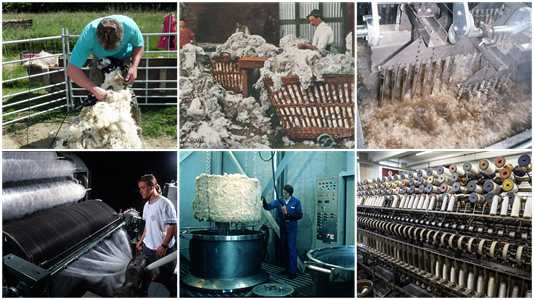
PUMPA - SMART LEARNING
எங்கள் ஆசிரியர்களுடன் 1-ஆன்-1 ஆலோசனை நேரத்தைப் பெறுங்கள். டாப்பர் ஆவதற்கு நாங்கள் பயிற்சி அளிப்போம்
Book Free DemoProcessing of wool:
The derivation and processing of wool involve five major steps. They are as follows:
- Shearing
- Grading or sorting
- Washing or scouting
- Carding
- Spinning

Processing of wool
1. Shearing:
The removal of the fleece of the sheep from its body is known as shearing. The sheep are sheared once a year, mainly during the spring season. The shearing of sheep is done by hand or by using new technologies in which robot-controlled arms do the clipping.
2. Grading and sorting:
2. Grading and sorting:
The breaking down of the fleece based on the overall quality is known as grading and sorting. The fleece from the same sheep may be different from different parts of the body. Hence, it is sorted out into separate piles of similar nature.
3. Washing and Scouting:
The wool obtained directly from the sheep is known as raw or grease wool. This wool is washed thoroughly with soap (or) detergents to remove dirt, dust, and grease during this step. The byproducts of this step are saved and used in a variety of household products.
4. Carding:
4. Carding:
During this step, the dried wool is carefully removed, and the fibres are passed through the rollers with a series of metal teeth that straighten and blend into slivers. This process arranges the wool into a flat sheet called a web. During carding, the residual dirt and other matter left in the fibres are also removed.
5. Spinning:
5. Spinning:
The web is pulled into narrow strands, which are subsequently spun into yarn. The strands are twisted into yarn by the spinning machinery. Wool balls are formed by winding the yarn. This yarn is either woven into the cloth or kept to knit it.
The video given below is regarding the processing of wool.
Uses of wool:
Wool is a multifunctional fibre with a wide range of diameters, making it suitable for clothing, household fabrics, and technical textiles. Two-thirds of the wool obtained is used to manufacture sweaters, coats, dresses, and active sportswear. Wool is also blended with other natural or synthetic fibres to add drape and crease resistance blankets, anti-static and noise absorbing carpets.
Reference:
https://www.maxpixel.net/Sheeps-Wool-Shearing-Sheep-Shearing-Wool-Sheep-1562779
https://www.flickr.com/photos/hwmobs/46586694615
https://upload.wikimedia.org/wikipedia/commons/thumb/3/35/CSIRO_ScienceImage_2911_Carding_Wool.jpg/512px-CSIRO_ScienceImage_2911_Carding_Wool.jpg
https://upload.wikimedia.org/wikipedia/commons/thumb/9/90/CSIRO_ScienceImage_2801_Wool_Scouring.jpg/512px-CSIRO_ScienceImage_2801_Wool_Scouring.jpg
https://upload.wikimedia.org/wikipedia/commons/thumb/8/8f/Wool_Spinning_Jenny_Helmshore_6156.JPG/512px-Wool_Spinning_Jenny_Helmshore_6156.JPG
https://upload.wikimedia.org/wikipedia/commons/thumb/7/7f/CSIRO_ScienceImage_2966_Wool_Fibre_Ready_for_Dyeing.jpg/512px-CSIRO_ScienceImage_2966_Wool_Fibre_Ready_for_Dyeing.jpg
https://www.publicdomainpictures.net/pictures/210000/velka/textile-industry-1487233203jPA.jpg